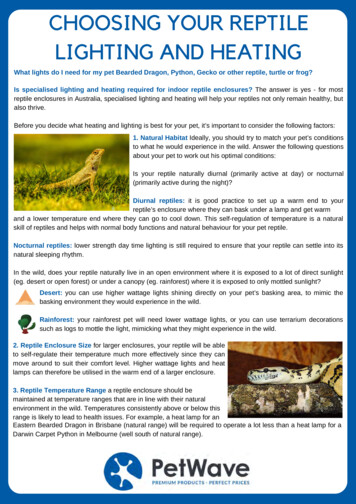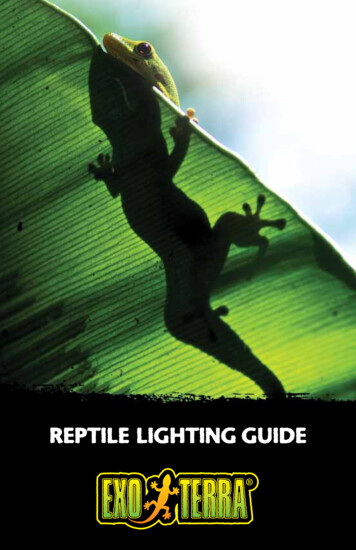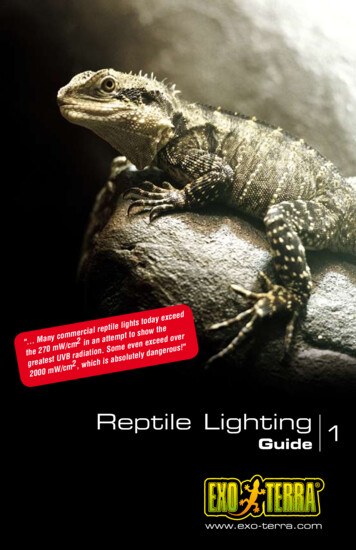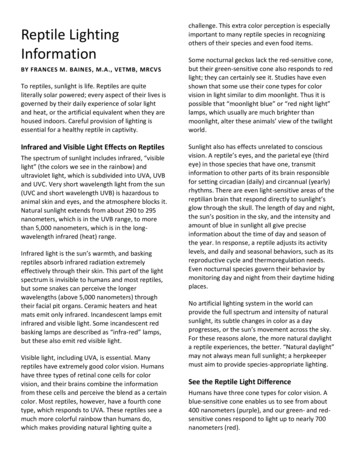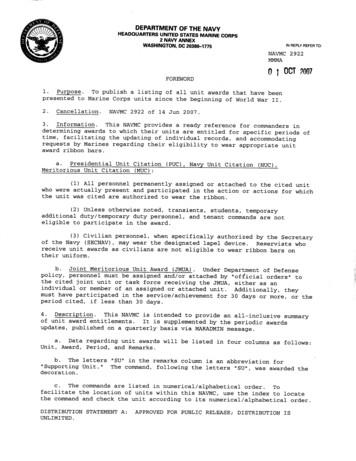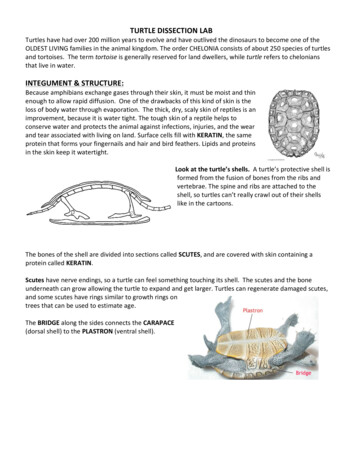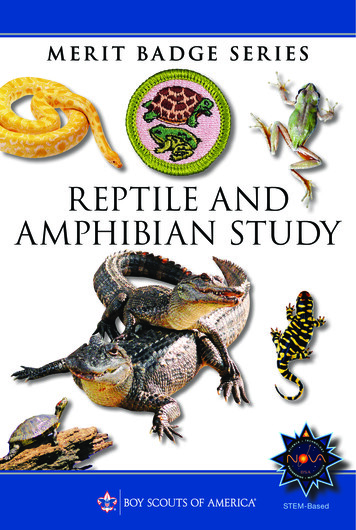
Transcription
REPTILE ANDAMPHIBIAN STUDYSTEM-Based
BOY SCOUTS OF AMERICAMERIT BADGE SERIESREPTILE ANDAMPHIBIAN STUDY“Enhancing our youths’ competitive edge through merit badges”
Reptile and Amphibian Study1. Describe the identifying characteristics of six species of reptiles and fourspecies of amphibians found in the United States. For any four of these, makesketches from your own observations or take photographs. Show markings,color patterns, or other characteristics that are important in the identificationof each of the four species. Discuss the habits and habitats of all 10 species.2. Discuss with your merit badge counselor the approximate number of species andgeneral geographic distribution of reptiles and amphibians in the United States.Prepare a list of the most common species found in your local area or state.3. Describe the main differences between(a) Amphibians and reptiles(b) Alligators and crocodiles(c) Toads and frogs(d) Salamanders and lizards(e) Snakes and lizards4. Explain how reptiles and amphibians are an important component of thenatural environment. List four species that are officially protected by thefederal government or by the state you live in, and tell why each is protected.List three species of reptiles and three species of amphibians found in yourlocal area that are not protected. Discuss the food habits of all 10 species.5. Describe how reptiles and amphibians reproduce.6. From observation, describe how snakes move forward. Describe the functionsof the muscles, ribs, and belly plates.7. Describe in detail six venomous snakes and the one venomous lizard found inthe United States. Describe their habits and geographic range. Tell what youshould do in case of a bite by a venomous species.8. Do ONE of the following:(a) Maintain one or more reptiles or amphibians for at least a month. Recordfood accepted, eating methods, changes in coloration, shedding of skins,and general habits; or keep the eggs of a reptile from the time of laying untilhatching; or keep the eggs of an amphibian from the time of laying until theirtransformation into tadpoles (frogs) or larvae (salamanders). Whichever youchose, keep records of and report to your counselor how you cared for youranimal/eggs/larvae to include lighting, habitat, temperature and humiditymaintenance, and any veterinary care requirements.(b) Choose a reptile or amphibian that you can observe at a local zoo,aquarium, nature center, or other such exhibit (such as your classroomor school). Study the specimen weekly for a period of three months. Ateach visit, sketch the specimen in its captive habitat and note any changes202
in its coloration, shedding of skins, and general habits and behavior. Discusswith your counselor how the animal you observed was cared for to includeits housing and habitat, how the lighting, temperature, and humidity weremaintained, and any veterinary care requirements.Find out, either from information you locate on your own or by talking to thecaretaker, what this species eats and what are its native habitat and homerange, preferred climate, average life expectancy, and natural predators.Also identify any human-caused threats to its population and any laws thatprotect the species and its habitat. After the observation period, share whatyou have learned with your counselor.9. Do TWO of the following:(a) Identify at night three kinds of toads or frogs by their voices. Imitate thesong of each for your counselor. Stalk each with a flashlight and discoverhow each sings and from where.(b) Identify by sight eight species of reptiles or amphibians.(c) Using visual aids, give a brief talk to a small group on three differentreptiles and amphibians.10. Tell five superstitions or false beliefs about reptiles and amphibians and givea correct explanation for each. Give seven examples of unusual behavior orother true facts about reptiles and amphibians.NOTE: Scouts must not use venomous reptiles in fulfilling requirement 8a. Species listed by federal or state law asendangered, protected, or threatened must not be used as live specimens in completing requirement 8a. When youdecide keeping your specimen is no longer possible or desired, be sure to find another appropriate home for it orreturn it to the wild at the location of capture. Check with your merit badge counselor for those instances where thereturn of these specimens would not be appropriate.Under the Endangered Species Act of 1973, some plants and animals are, or may be, protected by federal law. Thesame ones and/or others may be protected by state law. Be sure that you do not collect protected species.Your state may require that you purchase and carry a license to collect certain species. Check with the wildlife and fishand game officials in your state regarding species regulations before you begin to collect.203
.Reptile and Amphibian Study ResourcesReptile and AmphibianStudy ResourcesScouting LiteratureReptiles and Amphibians pocketguide; Bird Study, Fish and WildlifeManagement, Fishing, Fly-Fishing,Hiking, Insect Study, Mammal Study,and Nature merit badge pamphletsVisit the Boy Scouts of America’sofficial retail website at http://www.scoutstuff.org for a completelisting of all merit badge pamphletsand other helpful Scoutingmaterials and supplies.Field Guides to North AmericanReptiles and AmphibiansBehler, John L., and F. Wayne King.The Audubon Society Field Guideto North American Reptiles andAmphibians. Knopf, 1988.Conant, Roger, and Joseph T. Collins.A Field Guide to Reptiles andAmphibians of Eastern andCentral North America, 4th ed.Houghton Mifflin, 1998.Smith, Hobart M., and EdmundD. Brodie Jr. A Guide to FieldIdentification: Reptiles of NorthAmerica. Golden Guides from St.Martin's Press, 2014.Stebbins, Robert C. A Field Guide toWestern Reptiles and Amphibians,3rd ed. Houghton Mifflin, 2003.Tyning, Thomas F. Stokes Guide toAmphibians and Reptiles. Little,Brown, 1990.Natural History GuidesErnst, Carl H. Venomous Reptiles of theUnited States, Canada, and NorthernMexico: Crotalus (Volume 2). JohnsHopkins University Press, 2011.Ernst, Carl H., and Roger W. Barbour.Snakes of Eastern North America.George Mason University, 1989.Ernst, Carl H., Roger W. Barbour, andJeffery E. Lovich. Turtles of theUnited States and Canada, 2nd ed.Smithsonian, 2009.Greene, Harry W. Snakes: The Evolutionof Mystery in Nature. University ofCalifornia Press, 2000.Hofrichter, Robert. Amphibians: TheWorld of Frogs, Toads, Salamandersand Newts. Firefly Books, 2000.Petranka, James W. Salamanders ofthe United States and Canada.Smithsonian, 2010.REPTILE AND AMPHIBIAN STUDY77
Reptile and Amphibian Study Resources.Ross, Charles A. Crocodiles and Alligators.Facts on File, 1989.Organizations and WebsitesZug, George R., Carl H. Ernst, et al.Smithsonian Answer Book: Snakes, 2nded. Smithsonian Books, 2015.American Museum of Natural HistoryCentral Park West at 79th StreetNew York, NY 10024-5192Website: http://www.amnh.orgCaring for Reptiles and Amphibiansin CaptivityAmerican Society of Ichthyologists andHerpetologistsWebsite: http://www.asih.org/jobsBartlett, R.D. The 25 Best Reptile andAmphibian Pets. Barron’s EducationalSeries, 2006.Frye, Fredric L. A Practical Guide forFeeding Captive Reptiles. KriegerPublishing, 1991.Mattison, Christopher. The Care of Reptilesand Amphibians in Captivity. BlandfordPress, 1987.Rossi, John V. Snakes of the United Statesand Canada: Keeping Them Healthy inCaptivity. Krieger, 1992.Sounds of Frogs and ToadsThese are records or tapes of the calls of agreat many of our native frogs and toads.Bogert, Charles M. Sounds of NorthAmerican Frogs: The BiologicalSignificance of Voice in Frogs. CD ordownload. Smithsonian FolkwaysRecordings, 1998. Website: http://www.folkways.si.edu.AZA FrogWatch USA ProgramAssociation of Zoos and Aquariums8403 Colesville Road, Suite 710Silver Spring, MD 20910Website: http://www.aza.org/frogwatchNational Fish and Wildlife Foundation1133 15th St. NW, Suite 1100Washington, DC 20005Website: http://www.nfwf.orgNational Geographic SocietyP.O. Box 98199Washington, DC mNational Wildlife Federation11100 Wildlife Center DriveReston, VA 20190Website: http://www.nwf.orgNorth American Amphibian MonitoringProgramWebsite: http://www.pwrc.usgs.gov/naampElliott, Lang. The Frogs and Toads of NorthAmerica: A Comprehensive Guide toTheir Identification, Behavior, andCalls. Book and CD. Houghton MifflinHarcourt, 2009.Smithsonian National Zoological ParkWebsite: http://nationalzoo.si.eduKellogg, Peter P., and Arthur A. Allen.Voices of the Night. CD. Library ofNatural Sounds, 1982. Cornell Lab ofOrnithology, 159 Sapsucker WoodsRoad, Ithaca, NY 14850. Website: http://www.birds.cornell.edu.U.S. Fish and Wildlife Service1849 C St., NWWashington, DC 20240Website: http://www.fws.gov78REPTILE AND AMPHIBIAN STUDYSociety for the Study ofAmphibians and ReptilesWebsite: http://www.ssarherps.org
animal/eggs/larvae to include lighting, habitat, temperature and humidity maintenance, and any veterinary care requirements. (b) Choose a reptile or amphibian that you can observe at a local zoo, aquarium, nature center, or other such exhibit (such as your classroom . guide; Bird S
